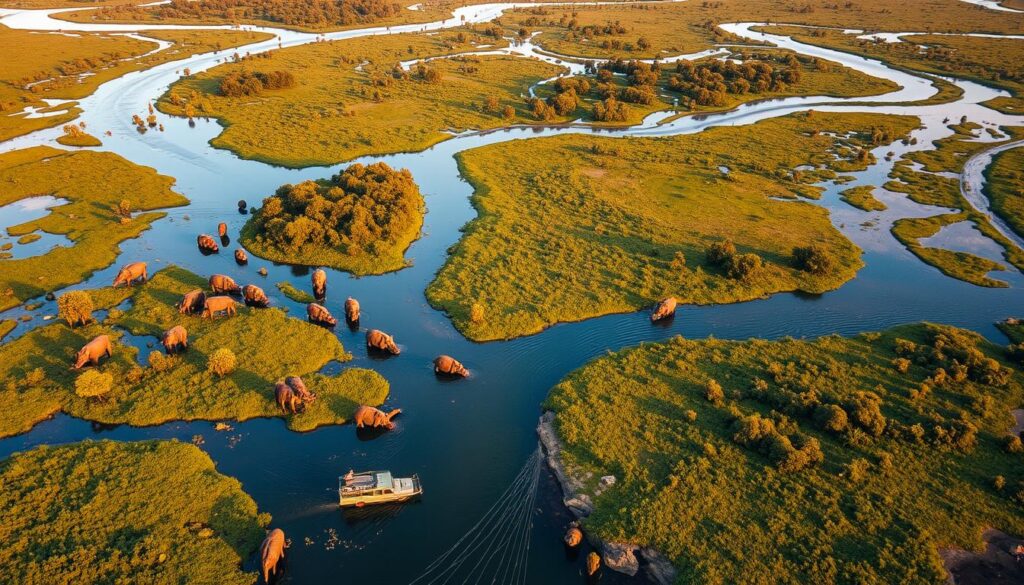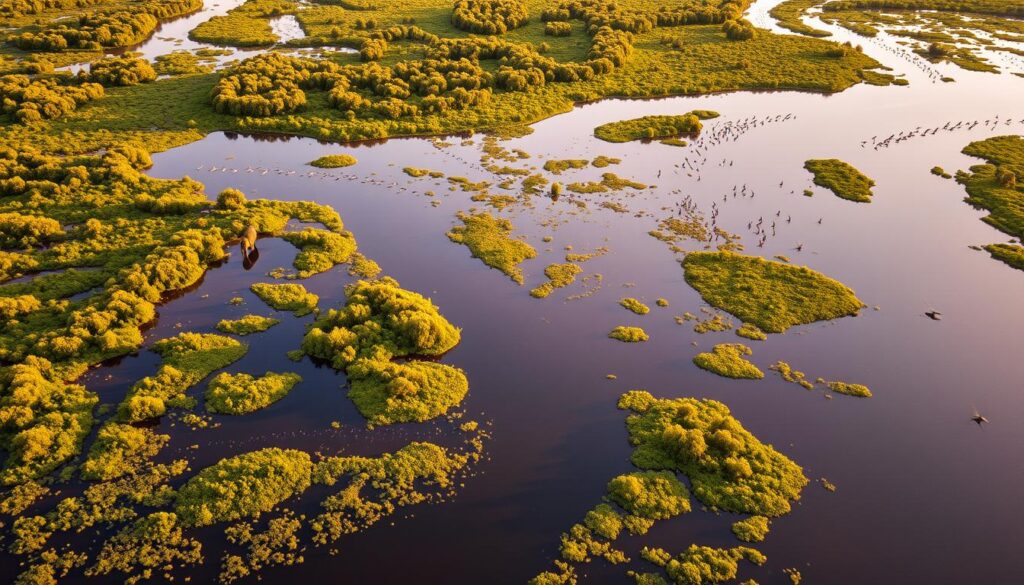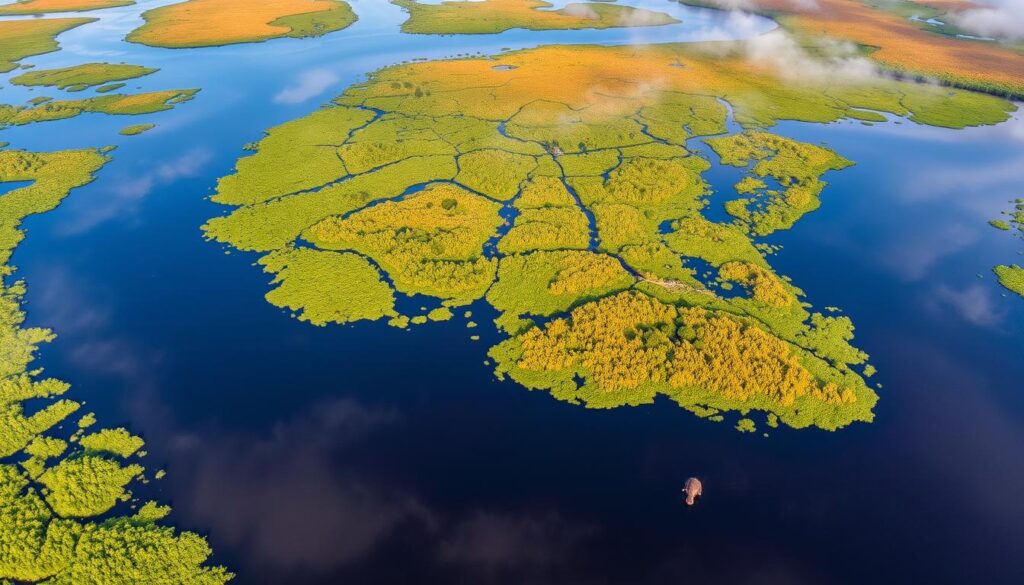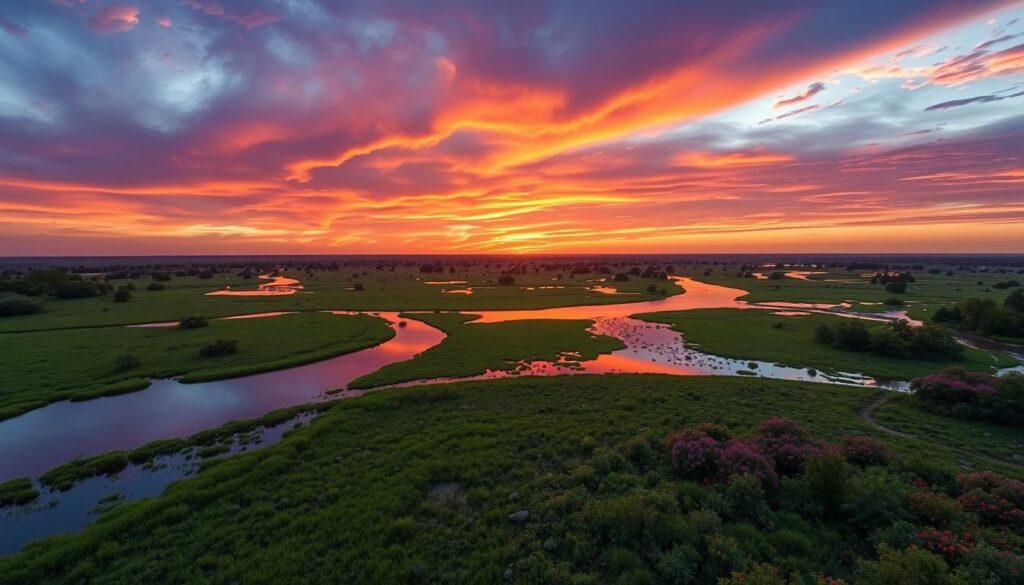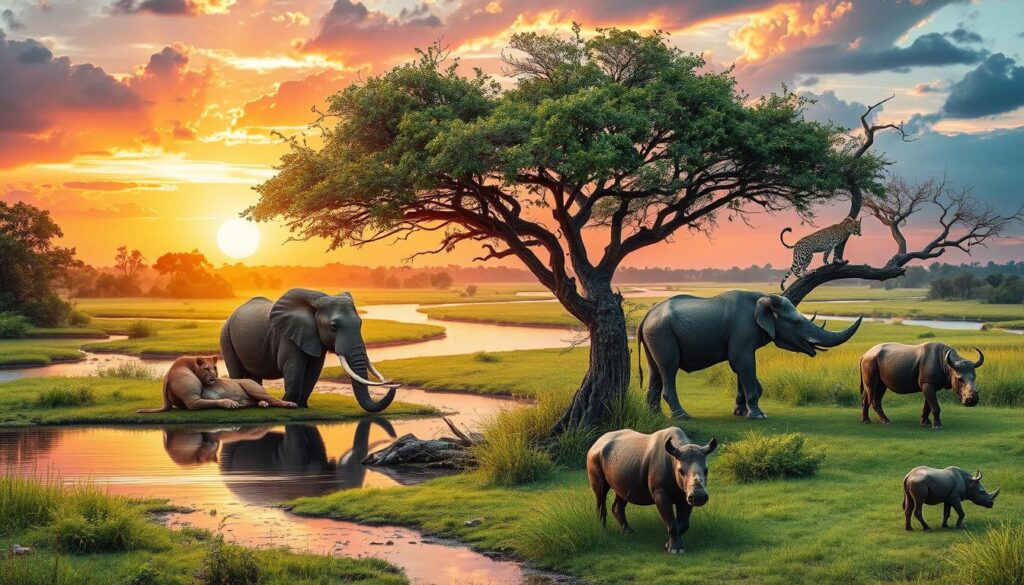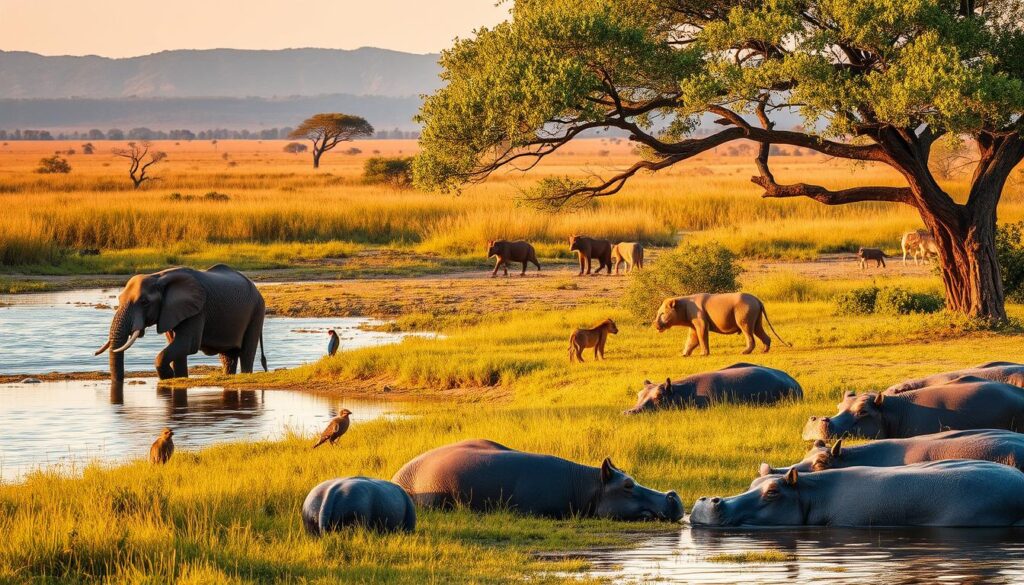As I looked out at the Okavango Delta, I felt amazed. This incredible inland delta is in Botswana’s heart. It’s full of life, with channels, lagoons, and islands. You can see African elephants and leopards here, showing the natural world’s beauty and strength.
The Okavango Delta is special because of the flood from Angola. This flood turns the dry land into a green paradise. The delta is full of different plants and animals, thanks to this flood. You can see everything from colorful bee-eaters to strong buffalo, all living in this changing world.
Key Takeaways
- The Okavango Delta is an inland wetland ecosystem in Botswana, not flowing into the sea, but spreading across the land.
- The annual flood from the Angola highlands fills the dry channels, transforming the landscape into a lush, biodiverse paradise.
- The delta is home to a wide variety of wildlife, including the Big Five and over 400 bird species.
- Conservation efforts have helped preserve the Okavango Delta, keeping it largely untouched by human development.
- The delta offers a unique and unforgettable African safari experience for travelers seeking a true wilderness adventure.
The Unique Geography of Africa’s Inland Delta
The Okavango Delta in Botswana is a unique wetland ecosystem that draws visitors worldwide. Unlike most river deltas, it never reaches the sea. Instead, it’s filled by the Okavango River’s seasonal flooding, which comes from the Angola highlands.
Formation and Seasonal Flooding Patterns
The Okavango Delta blooms during the flood season. Rain in the Angola highlands, three times more than in Botswana, fills the delta. This flooding is crucial for the wetland ecosystem, supporting its diverse life.
The Remnants of Ancient Lake Makgadikgadi
The Okavango Delta is part of the Makgadikgadi Basin, once an ancient lake. The dry salt pans around the delta contrast with its lush wetlands. This shows the area’s dynamic nature, making it a great spot for sustainable tourism.
Water Flow and Distribution Systems
Though the Okavango Delta gets a lot of water, only 2% reaches Lake Ngami. Most water is absorbed by plants or evaporates. This shows the wetland ecosystem‘s delicate balance and resilience.
| Water Flow Breakdown | Percentage |
|---|---|
| Absorbed by plants | 60% |
| Evaporated | 36% |
| Replenishes the aquifer | 2% |
| Flows into Lake Ngami | 2% |
“The Okavango Delta is one of Africa’s most remarkable wildlife-viewing areas, hosting thousands of animals that migrate there annually.”
The Miraculous Annual Flood Cycle
The Okavango Delta in Botswana is a natural wonder. Its annual flood cycle is a sight to see. Heavy rains in Angola start the flood in November. The Okavango River fills the delta, turning it into a lush paradise. The Okavango Delta covers an area as big as Jamaica, offering great African safari and wildlife viewing spots.
The delta grows to three times its size from March to April. The Okavango River brings in a lot of rain, feeding the delta’s diverse life. The Okavango Delta is home to a staggering 160 mammal species, 155 reptiles, 35 amphibians, 71 fish, 400 bird species, and 1,500 plant species. It’s a hotspot for African safari and wildlife viewing lovers.
- The Okavango Delta is home to more than 60,000 lechwe antelope and one of the largest endangered African wild dog populations in Africa.
- The Delta region is located in northwest Botswana and consists of three main geographical areas: Panhandle, Delta, and Dryland.
- The Panhandle region features an 80-kilometer river with local communities and excellent fishing spots.
- The Dryland region includes Chief’s Island, the largest island in the Okavango Delta, spanning about 70 kilometers long and 15 kilometers wide.
As the floodwaters recede in October, the cycle starts again. This ensures the Okavango Delta remains a thriving African safari and wildlife viewing spot.
“The Okavango Delta in Botswana has an estimated size of a little over 15,000 square kilometers (5,790 square miles), which is approximately half the size of Switzerland.”
Botswana’s Okavango Delta: A Watery Wonderland
The Okavango Delta is in the heart of Botswana. It’s a natural wonder filled with different ecosystems and lots of wildlife. This UNESCO World Heritage Site is a mix of lush marshlands, calm lagoons, winding channels, and peaceful islands.
Diverse Ecosystems Within the Delta
The Okavango Delta is a changing wetland. The annual flood shapes its landscape and supports many habitats. From deep channels to shallow floodplains, each part is crucial for the delta’s plants and animals.
Islands and Channels Formation
The delta’s islands and channels have a unique story. Chief’s Island, the biggest, was once the chief’s hunting area. It was formed by a fault line. Now, it’s a wildlife sanctuary, showing visitors the delta’s beauty.
The Role of Seasonal Changes
The Okavango Delta changes with the seasons. The flood season is from May to September, and the dry season is from October to April. These changes make the delta’s habitats dynamic, offering great wetland ecosystem and wildlife viewing spots.
“The Okavango Delta is one of the Seven Natural Wonders of Africa, and it’s easy to see why. This sprawling, unspoiled wetland ecosystem is a true marvel of nature.”
Wildlife Abundance in the Delta
The Okavango Delta is a haven for wildlife lovers. It’s home to many animal species. This place is full of iconic African safari animals and rare creatures.
The delta is famous for its hippopotamus, known for its size and unique mouth. You’ll see blue wildebeest, giraffe, and plains zebra eating grass. Nile crocodiles hide in the water, while warthogs and Chacma baboons roam around.
The delta is known for its elephants and buffalo. These big animals move through the wetlands in big groups. You can also see over 60,000 lechwe antelope with their special fur.
| Animal Species | Population Estimates |
|---|---|
| Lechwe Antelope | Over 60,000 |
| Elephants | Large Herds |
| Buffalo | Large Herds |
| Bird Species | Over 400 |
The delta is also home to the rare sitatunga antelope. It can even sleep underwater, showing only its nostrils. Over 400 bird species live here, like the African fish eagle and the Pel’s fishing owl.
“The Okavango Delta is a true oasis of life, teeming with an incredible array of wildlife viewing opportunities. From the mighty elephant to the secretive sitatunga, this watery wonderland never fails to captivate and inspire.”
The Big Five and Rare Species Encounters
The Okavango Delta in Botswana is a top spot for seeing the Big Five: lions, leopards, elephants, buffalo, and rhinos. This place is full of these amazing animals, giving visitors a unique wildlife viewing chance.
Reintroduced White Rhinos
The Okavango Delta is proud of bringing back white rhinos to the Moremi Game Reserve. These big animals were almost gone due to poaching. Now, they live safely here, letting visitors see them.
African Wild Dog Conservation
The Okavango Delta is key for saving the African wild dog, a very rare animal. It has one of Africa’s biggest wild dog packs. Visitors can see these amazing dogs in their home.
Predator-Prey Relationships
The Okavango Delta is great for seeing how predators and prey live together. You might see a lion chasing buffalo or a leopard waiting for its next meal.
| Best Time to Visit | Wildlife Viewing Highlights |
|---|---|
| June to August | Excellent for spotting the Big Five, including reintroduced white rhinos, as well as African wild dogs and other predators |
| September to November | Exceptional for observing large herds of elephants and buffalo, and witnessing predator-prey interactions |
Looking for the Big Five or rare animals? The Okavango Delta gives an amazing luxury wildlife viewing experience.
Exploring Moremi Game Reserve
Moremi Game Reserve is a treasure at the Okavango Delta’s eastern end. It’s named after Chief Moremi of the BaTawana tribe. This area is known for its incredible variety of plants and animals.
The reserve covers over 5,000 square kilometers. It has many different landscapes, like floodplains and forests. Here, you can see many animals, including the Big Five and rare birds.
Chief’s Island is a key spot in Moremi. It’s a high point where you can see many animals. You might even see white rhinos, thanks to conservation efforts.
| Wildlife Found in Moremi Game Reserve | Percentage of Total Wildlife in the Reserve |
|---|---|
| Elephants | 25% |
| Lions | 15% |
| Leopards | 10% |
| Cheetahs | 5% |
| Wild Dogs | 3% |
| Other species (including Tsessebe, birds, and more) | 42% |
Moremi Game Reserve is a unique place for an African safari. It has many animals and beautiful landscapes. It’s perfect for those who love wildlife and nature.
Traditional Mokoro Safaris and Water Adventures
Exploring the Okavango Delta on a traditional mokoro safari is unique. These eco-friendly canoes let you see wildlife up close. You’ll feel the Delta’s beauty in a way you never have before.
Types of Water-Based Activities
The Okavango Delta also has motorboat rides for those who want to see more. These rides are fast and let you see different animals. Everyone can find an activity that fits their style.
Best Viewing Opportunities
The best time to see wildlife is from June to October. Animals gather around water, making it easy to spot them. The area’s sustainable tourism lets you enjoy these moments without harming the environment.
| Activity | Duration | Cost per Person (Sharing) | Single Supplement |
|---|---|---|---|
| Mokoro Trip – 1 Night | 1 Night | $185.00 | $60.00 |
| Mokoro Trip – 2 Nights | 2 Nights | $230.00 | $90.00 |
| Mokoro Trip – 3 Nights | 3 Nights | $275.00 | $120.00 |
| Fully Catered Mokoro Trip – 2 Days | 2 Days | $315.00 | 25% of Total Cost |
| Fully Catered Mokoro Trip – 3 Days | 3 Days | $470.00 | 25% of Total Cost |
| Fully Catered Mokoro Trip – 4 Days | 4 Days | $630.00 | 25% of Total Cost |
“Gliding silently through the Okavango Delta on a traditional mokoro is a truly unforgettable experience that immerses you in the heart of this African safari destination.”
Luxury Lodges and Private Concessions
The Okavango Delta in Botswana is a true wonderland. It offers a range of accommodations, from cozy tented camps to luxury lodges. These exclusive luxury lodges are nestled in the delta’s channels and islands. They provide travelers with an unparalleled safari experience.
The Xigera Safari Lodge is a gem in the Wilderness Safaris collection. It has 12 suites, most facing east over the floodplains. Xigera runs on a sustainable Tesla solar hybrid-power system, meeting nearly 100% of its energy needs. The staff has been with Xigera for decades, offering guests a personalized experience.
Xigera is committed to sustainable tourism. It has eco-friendly initiatives like a composter and biodegradable cleaning products. The lodge also uses state-of-the-art technology to purify its water, reducing its environmental impact.
“Xigera is a true haven of luxury and sustainability, offering guests an unforgettable safari experience in the heart of the Okavango Delta.”
Xigera offers more than just luxury accommodations. It has a world-class spa, a gym, pool, and yoga pavilion. Guests can enjoy various dining experiences, all while surrounded by wildlife.
The Okavango Delta is home to many luxury lodges and private concessions. Each offers a unique safari experience. These areas, like the Kwara Concession, limit visitors and vehicles. This ensures an intimate and undisturbed encounter with wildlife.
Whether you want a tranquil retreat or an adrenaline-fueled adventure, the Okavango Delta’s lodges and concessions are perfect. They offer a gateway to Botswana’s sustainable tourism offerings. Immerse yourself in the delta’s watery wonderland and experience the ultimate in safari luxury.
Conclusion
The Okavango Delta is a true watery wonderland. It turns the dry Kalahari Desert into a lively oasis every year. This amazing place is full of wildlife, showing us nature’s strength and the need for green tourism.
Visitors can see the delta’s beauty by canoe or on an African safari. They get to see a world full of wonder and beauty.
The Okavango Delta’s story of conservation is inspiring. It shows how important it is to travel responsibly and work with local communities. Eco-tourism and partnerships help keep the delta safe for the future.
Travelers can help protect the Okavango Delta by choosing green travel. This way, we can all help keep this incredible place safe.
The Okavango Delta offers unforgettable experiences. Whether you want luxury or adventure, it has something for everyone. By visiting, we can make memories and help protect this unique African landscape.
